Let Freedom Swing
Let Freedom Swing brings outstanding performances to community audiences. Offering performances, workshops, collaborations, and instrumental clinics for audiences of all ages, Let Freedom Swing explores a wide range of jazz topics through the lens of American history. Since 2013, Let Freedom Swing has reached over half a million people in over 3,500 concerts around the world.
EDUCATION
What is Jazz?
Jazz grew out of the African-American community in the turn of the 20th century New Orleans. It is a mingling of the musical expressions of all the people who came to the United States by choice or by force—people from Africa, Europe, Latin America and the Caribbean—as well as those already living in America. Jazz musicians brought their traditions together (with special emphasis on the blues, church spirituals and ragtime) in a new, universal language. Through the blues, jazz musicians showed that the sorrows common to us all could be overcome with optimism and humor.
Through improvisation they celebrated newfound expressive freedom. And through the joyous rhythms of swing, they taught the many different people of New Orleans that they could work together with feeling and style.
Jazz spoke to all Americans and quickly spread upriver to St. Louis, Kansas City, Chicago, New York, and beyond. In the 1920s new technologies like radio, the phonograph and talking motion pictures made it possible for millions to hear jazz across America and around the world. The propulsive rhythms of swing invited these new listeners to tell their stories too.
As new generations of musicians filled the music with the depth of their personality, jazz evolved from small groups of early jazz to the brassy big bands of the swing era, the flashy virtuosity of bebop, to laid-back cool jazz, to fusion, free jazz and far beyond. Jazz has since become a part of every American’s birthright, a timeless symbol of individualism and ingenuity, democracy and inclusiveness. At its very core, this music affirms our belief in community, in love, and in the dignity of human life. And if we let it, jazz can teach us—in ways beyond our imagination—exactly who we are, where we have been, and where we should be going
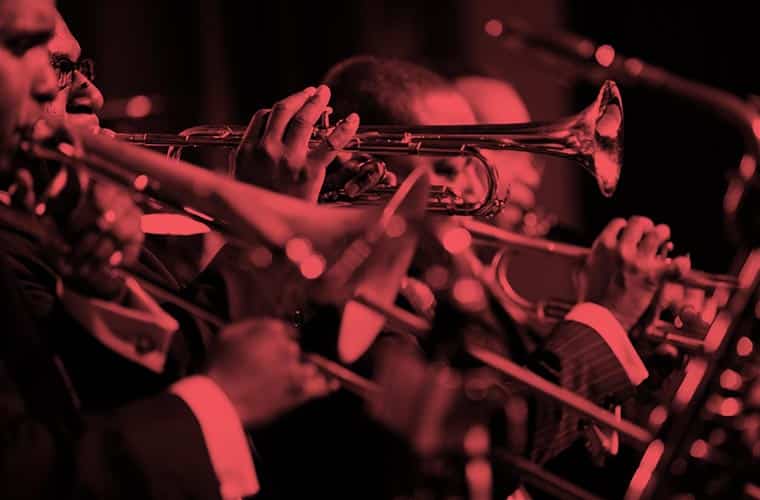

Jazz and Democracy
American democracy was designed from the very beginning around the idea of personal freedom. These key phrases from early American history—“We the People,” “E Pluribus Unum” and “A More Perfect Union”—have served as important themes for our nation since its founding.
“We the People” are the first three words of the United States Constitution and highlight the truly revolutionary nature of the American historical enterprise in placing unprecedented faith in the ability of its citizens to establish a republic:
We the People of the United States, in Order to form a more perfect Union, establish Justice, insure domestic Tranquility, provide for the common defense, promote the general Welfare, and secure the Blessings of Liberty to ourselves and our Posterity, do ordain and establish this Constitution for the United States of America.
“E Pluribus Unum” (Latin for “Out of Many, One,”) was inscribed in 1776 on the face of the Seal of the United States. Long considered the official motto of the United States, “E Pluribus Unum” was as important in the 18th century as it is today in establishing an ideal for the nation—that many, different peoples could come together to form one society. “A More Perfect Union” is a phrase that appears in the first section of the U.S. Constitution. This idea captures the aspirations of the early republic to continue to improve over time, a difficult and challenging project, both then and now.
These ideas are relevant to the world of jazz as well: a group of diverse musicians negotiating in time to create a collective expression that reflects the unique personalities and values of each individual for the good of everyone. The traditions of experimentation and improvisation in jazz resemble the innovative approach of America’s democracy in placing so much faith in its people and in striving to invent something new, different, and perhaps, even better.
Key Figures
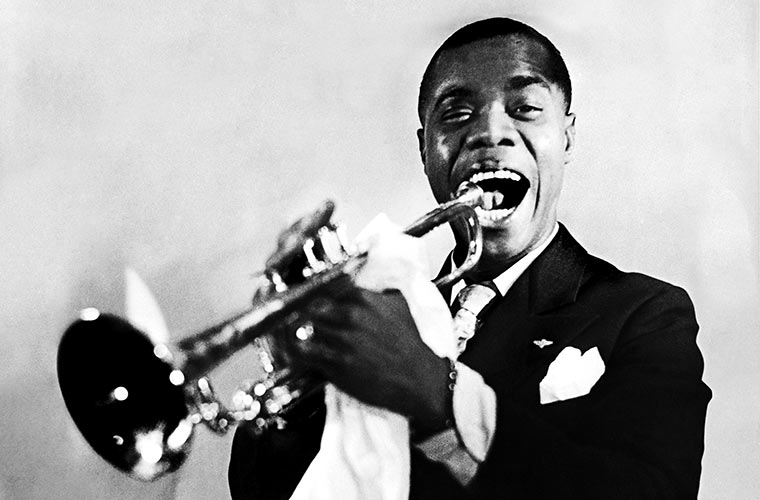
Louis Armstrong
Trumpet player and singer LOUIS ARMSTRONG is considered the most important improviser in jazz. With his infectious, wide grin and instantly recognizable gravelly voice, he won the hearts of people everywhere. Armstrong grew up in a poor family in a rough section of New Orleans. He started working at a very young age to support his family, singing on street corners, working on a junk wagon, cleaning graves for tips, and selling coal. His travels around the city introduced him to all kinds of music, from the blues played in the Storyville honky tonks to the brass bands accompanying the New Orleans parades and funerals.
The music that surrounded him was a great source of inspiration. As the young Armstrong began to perform around New Orleans, he captured the attention and respect of some of the older established musicians. Joe “King” Oliver, one of the finest trumpet players around, became Armstrong’s mentor. In 1922, Armstrong left New Orleans and began his lifetime of touring and recording. Armstrong’s innovations influenced every instrumentalist and every singer who followed him. He was, as the trumpet player Max Kaminsky wrote, “the heir of all that had gone before and the father of all that was to come.
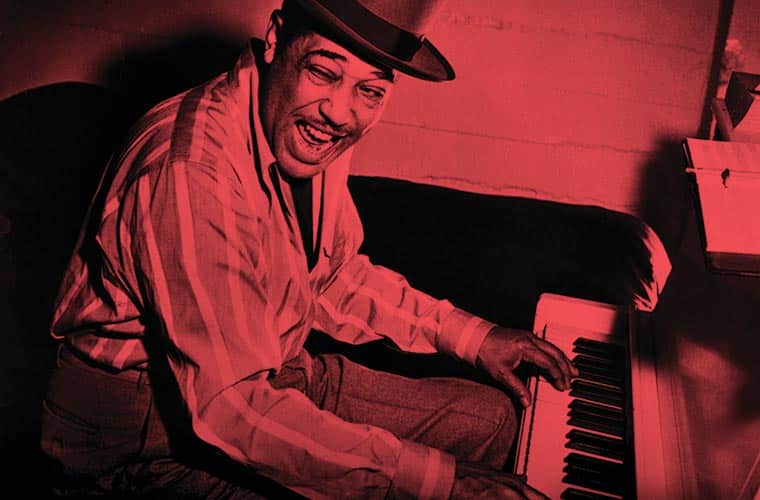
Duke Ellington
“If jazz means anything,” DUKE ELLINGTON once said, “it is freedom of expression.” No one in the history of jazz expressed himself more freely—or with more variety or swing or sophistication. He was a masterful pianist but his real instrument was the orchestra he led for half a century. More consistently than anyone else in jazz history, Ellington showed how great music could simultaneously be shaped by the composer and created on the spot by the players. Each of his almost 2,000 compositions—love songs and dance tunes, ballet and film scores, musical portraits and tone poems, orchestral suites and choral works and more—was crafted to bring out the best in one or another of the extraordinary individuals who traveled the road with him. Ellington hated what he called “categories,” and refused to conform to anyone else’s notion of what he should be doing. As a result he managed to encompass in his music not only what he once called “Negro feeling put to rhythm and tune” but the rhythm and feeling of his whole country and much of the wider world, as well.
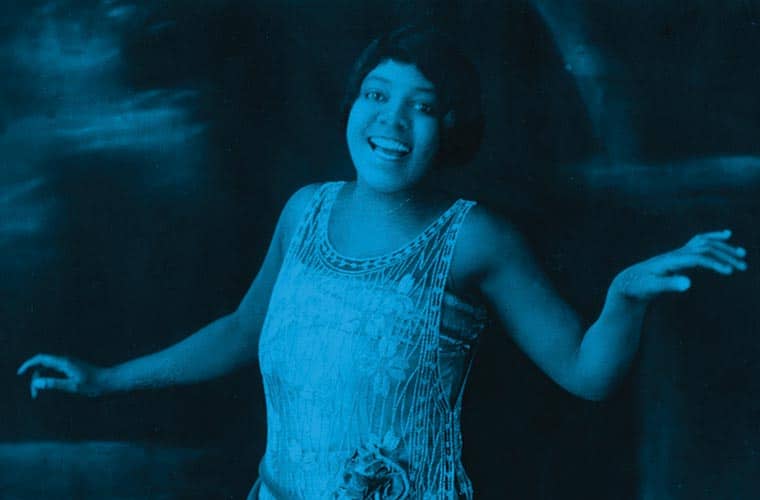
Bessie Smith
BESSIE SMITH was a fabulous deal to watch,” the banjoist Danny Barker remembered. “She was a large pretty woman and she dominated the stage. You didn’t turn your head when she went on. You just watched Bessie.” Her stage presence may have mesmerized audiences but it was her huge, confident voice, captured on records and capable of conveying every human emotion from grief to joy without a hint of sentimentality or self-pity, that made her the acknowledged Empress of the Blues. She began her show business career in 1912 as a chorus girl with a touring tent show, Ma Rainey’s Rabbits Foot Minstrels. She was not the first singer to record the blues. That honor went to Mamie Smith (no relation) who set off the blues craze in 1920.
But from the time she began to record in 1923, Bessie Smith out-sang and out-sold all her rivals. Great musicians accompanied her—Louis Armstrong, Sidney Bechet, James P. Johnson and more—but she was always the star, traveling in her own private railroad car, drawing huge crowds wherever African Americans lived, north as well as south, and admired by growing numbers of whites, as well.
“Jazz calls us to engage with our national indentity. It gives expression to the beauty of democracy and of personal freedom and of choosing to embrace the humanity of all types of people. It really is what American democracy is supposed to be.”
— Wynton Marsalis
What is Jazz? Playlist
Big Ideas

Democracy
A system in which everyone can vote and share in making descisions.

Citizen
A member of a community, having rights, privileges as well as obligations.

Freedom
The right to do what you want, to make your own descisions, and express your own opinions.

What are the Blues?
An African American music developed in the South during the mid-1800s. It is the foundation of most American popular music. The blues is capable of expressing a wide range of emotions, often including sadness or loss.
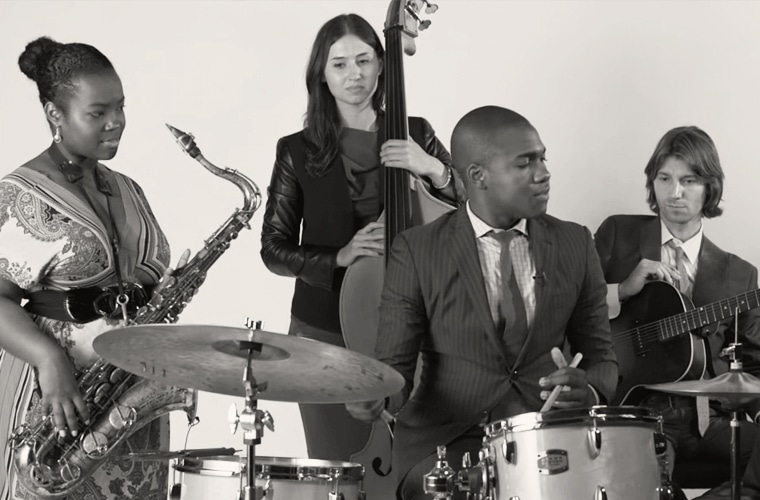
What is Swing?
The basic rhythmic attitude of jazz. When a whole band is swinging it means everyone is listening to and balancing with one another while still expressing their unique personalities. Swing also refers to a specific style of jazz for dancing featuring large ensembles.

What is Improvisation?
The act of making something up on the spur of the moment.